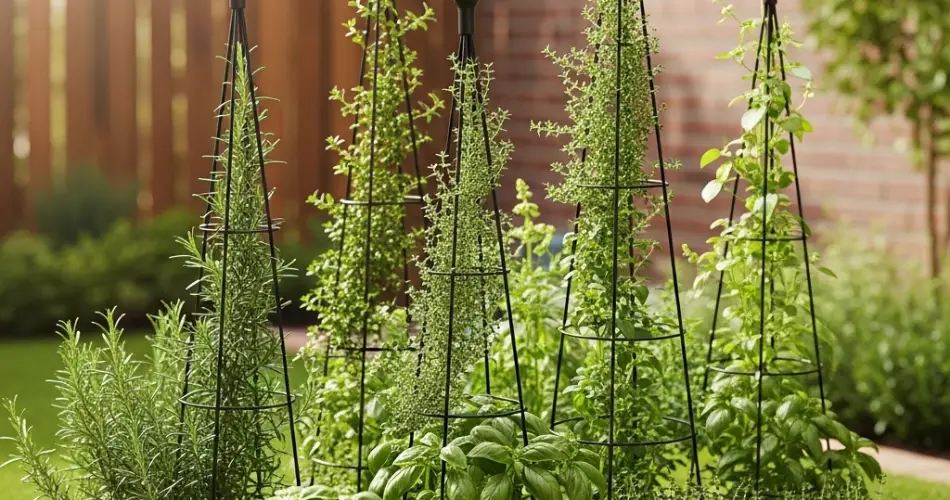Culinary herbs are an essential part of any kitchen garden, adding flavor, aroma, and freshness to a wide variety of dishes. While many herbs grow compactly, certain varieties, such as climbing thyme, rosemary, oregano, and sweet peas used as edible flowers, benefit from vertical support. Metal frames offer a practical and durable solution for guiding these climbing herbs, helping them grow upright, stay healthy, and produce abundant foliage. With the right frame, gardeners can maximize space, improve airflow, and create an attractive, organized herb garden.
Why Use Metal Frames for Climbing Culinary Herbs?
Climbing herbs naturally spread and can tangle when allowed to grow unchecked. Without support, stems may become weak, foliage can crowd the soil, and airflow is reduced, increasing the risk of fungal infections and pests. Metal frames provide a sturdy structure for vines to climb, keeping plants upright, well-spaced, and healthy. Vertical growth also improves light exposure for leaves, which is essential for photosynthesis and overall plant vigor. For gardeners with limited space, such as balconies, patios, or small backyard plots, metal frames allow for compact yet productive herb cultivation.
Choosing the Right Metal Frame
Selecting the appropriate metal frame is crucial for supporting climbing herbs. Frames can be made from galvanized steel, aluminum, or coated iron, ensuring resistance to rust and long-term durability. Popular designs include A-frame trellises, vertical grids, and cage-style structures. For climbing culinary herbs, choose a frame tall enough to accommodate mature plants—typically 4–6 feet—and wide enough to allow multiple stems to climb without overcrowding. Secure the frame firmly in the soil or pots to prevent tipping as vines grow and gain weight.
Preparing Climbing Herbs for Vertical Support
Before installing metal frames, prepare the herbs and soil for optimal growth. Most climbing herbs thrive in well-draining, nutrient-rich soil, enriched with compost or organic fertilizer. Choose a sunny location, as herbs like rosemary, thyme, and oregano prefer at least 6–8 hours of direct sunlight daily. When growing herbs in containers, ensure the pots are large enough to accommodate root systems and provide stable support for the frame. Installing the frame early in the growing season encourages young stems to climb naturally, creating structured vertical growth from the start. Mulching around the base helps retain moisture, suppress weeds, and regulate soil temperature.
Training Climbing Herbs on Metal Frames
Training herbs on metal frames involves gently guiding stems along the structure and securing them loosely with soft ties, twine, or cloth strips. Avoid tying stems too tightly, as this can restrict growth or damage the plant. Encourage lateral shoots to climb or rest along the frame to maximize vertical coverage. For heavier or sprawling herbs, such as larger rosemary plants, use additional support by weaving stems through the frame or providing multiple tie points. Regular monitoring and adjustments help maintain upright growth and ensure plants remain healthy and productive.
Pruning and Maintenance
Pruning is an essential aspect of maintaining healthy climbing herbs. Remove yellowing, damaged, or overcrowded leaves to improve airflow and light penetration. Pinch back excessive shoots to focus energy on producing flavorful foliage. Regularly inspect plants for pests such as aphids, spider mites, and caterpillars, and manage infestations with organic solutions like neem oil or insecticidal soap. Routine maintenance ensures vigorous growth, healthy leaves, and a tidy, organized vertical garden.
Watering and Fertilizing
Climbing herbs on metal frames require consistent watering, but avoid overwatering, as many herbs prefer slightly drier conditions. Check soil moisture regularly, watering when the top inch feels dry. Container-grown herbs may require more frequent hydration. Fertilize every few weeks with a balanced, organic fertilizer to encourage robust growth, stronger stems, and abundant foliage. Proper watering and feeding help herbs climb effectively while maintaining optimal flavor and aroma.
Harvesting Herbs from Metal Frames
Vertical growth makes harvesting easier, as leaves and stems are more accessible. Regular harvesting encourages new growth and prevents plants from becoming too woody or overgrown. Use clean scissors or garden shears to trim leaves or stems carefully, taking care not to damage main branches or surrounding foliage. Harvesting from metal-supported plants ensures that stems remain strong and plants continue producing throughout the growing season.
Final Tips for Vertical Culinary Herb Gardens
Metal frames provide an effective, durable, and attractive solution for growing climbing culinary herbs. By selecting sturdy structures, training stems early, maintaining proper care, and pruning regularly, gardeners can enjoy healthy, productive herbs that maximize vertical space. Vertical cultivation improves airflow, sunlight exposure, and accessibility while keeping plants organized and visually appealing. With proper attention, climbing herbs supported by metal frames will thrive, offering abundant, flavorful foliage that elevates home cooking and enhances the beauty of any garden space.



